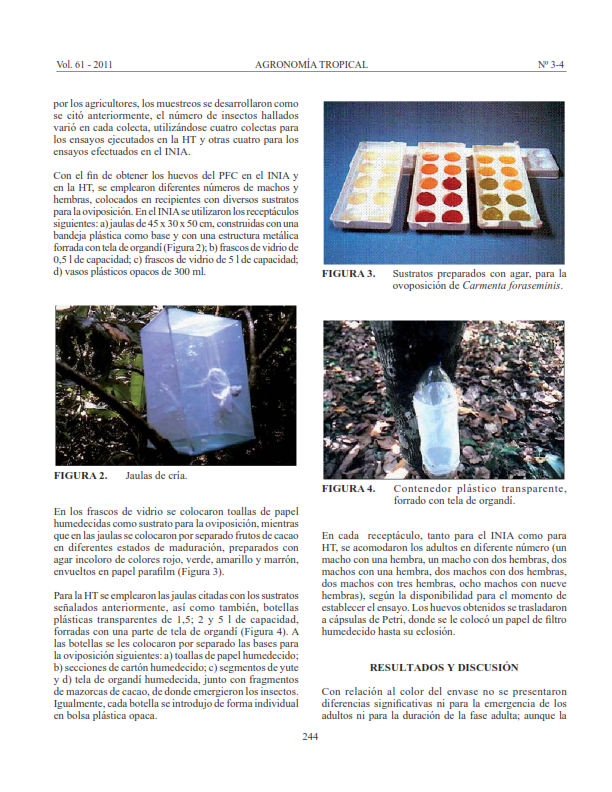Adult phase duration males and females emergency of cocoa fruit borer in Choroni and Maracay, Aragua State
Abstract
The species Carmenta foraseminis pest of cocoa, Theobroma cacao L., hardly oviposit in captivity. So to know some aspects of its biology research was undertaken in two locations of Aragua State, Venezuela: Maracay (My) and Choroní (Ch). In Ch, samples were taken in the stacks of cocoa pods ready for shelling. From damaged fruits were collected larvae and pupae that were subsequently used in the trials. In addition, tests were made to determine if the color (black or white) and the type of container affect the emergence and duration of the adult stage, the matter did not show significant statistical differences. Similarly, tests were performed on the cycle of the adult stage, emergence percentage by sex, morning and evening hours. Data analysis were used binomial test and chi-square for two ratios, additionally, different containers were tested and substrates for obtaining eggs. My significant differences in the proportions of males and females emerged. Also, highly significant differences were detected for the number of pupae that managed to reach the adult stage and location of the emergency, emergency being greater Ch, where no significant differences were observed with respect to the times indicated, but it got eggs in the container that had sections of cocoa with pupal exuviae C. foraseminis.
Downloads
References
• Bergh, J., T. Leskey, J. Sousa and A. Zhang. 2006. Diel periodicity of emergence and premating reproductive behaviors of adult dogwood borer (Lepidoptera: Sesiidae). Environ. Entomol. 35(2):435-442.
• Booth, D. Clearwing borers. 2005. Disponible en: https://bit.ly/2QEPGyN
• Consultoría y Capacitación 2011. Manual de Excel Avanzado. S. C., Méjico. Monografia. 36 p.
• Cottrell, T., J. Fuest and D. Horton. 2008. Influence of Prunus spp., peach cultivars, and bark damage on oviposition choices by the lesser peachtree borer (Lepidoptera: Sesiidae). Environ. Entomol. 37(6):1 508-1 513.
• Delgado, N. 2004. Taxonomía y bioecología de los perforadores (Lepidoptera: Sesiinae) del fruto del cacao (Theobroma cacao), en la región centro costera del estado Aragua. Trabajo de ascenso. Maracay, Ven. Universidad Central de Venezuela. Facultad de Agronomía 98 p.
• Derksen, S. 2006. Semiochemical-mediated oviposition behavior by peachtree borer, Synanthedon exitiosa (Lepidoptera: Sesiidae). Tesis. Canadá. Univ. Simon Fraser. 53 p.
• Derksen, S., M. Chatterton, R. Gries, M. Aurelian, G. Judd and G. Gries. 2007. Semiochemical-mediated oviposition behavior by female peachtree borer, Synanthedon exitiosa. Entomol. Exp. et Applicata. 123(2):101-108.
• Dogwood, Borer. 2005. Synanthedon scitula (Harris), Sesiidae, Lepidoptera. Disponible en: https://bit.ly/2wv8l9d Consultada: 25/06/2005.
• Ellis, H. and D. Horton. 1999. Grape Root Borer. Vitacea polistiformes (Harris). Weevils and Borers. Roberts y Douce (Coordinators). Disponible en: https://bit.ly/2QBShcM. Consultada: 25/06/2005.
• Frank, D., T. Leskey and J. Bergh. 2010. Development of a Rearing Methodology for the Dogwood Borer (Lepidoptera: Sesiidae). Ann. Entomol. Soc. Am. 103(1):50-56.
• García, J. y R. Montilla. 2010. Hymenopteros parasitoides de insectos asociados a las plantaciones de cacao, en la región costera del estado Aragua, Venezuela. Agronomía Trop. 60(1):91-97
• Gentry, C. and J. Wells. 1982. Evidence of an oviposition stimulant for peachtree borer. J. Ch. Ecol. 8(8):1 125-1 132.
• Karimpour, Y., Y. Fathipour, A. Talebi y S. Moharramipour. 2007. Biology of Chamaesphecia schizoceriformis (Lep.: Sesiidae), a biocontrol agent of Euphorbia boissieriana (Euphorbiales: Euphorbiaceae) in north west of Iran. J. Entomol. Soc. Iran 26(2):35-45.
• Mora, J. 2004. Lepidópteros plagas en el cultivo del cacao (Theobroma cacao L.) en Venezuela. Tesis. Maracay, Ven. Universidad Central de Venezuela. Facultad de Agronomía 56 p.
• Morillo, F., D. Parra, P. Sánchez, J. Guerra, W. Muñoz, I. Contreras. y J. Pineda. 2001. Diagnóstico fitosanitario en el cultivo del cacao (Theobroma cacao L.) realizados por el Departamento de Protección Vegetal del INIA-Miranda. XVII Congreso Venezolano de Entomología. Resúmenes 69 p.
• Morillo, F., P. Sánchez, B. Herrera and C. Liendo. 2009. Pupal development, longevity and behavior of Carmenta theobromae (Lepidoptaera: Sesiidae). Florida Entomol. 92(2):355-361.
• Navarro, R. 2003. Seminarios CENIAP 2003. Alternativas de control cultural, etológico y biológico de insectos asociados al cacao en los estados Miranda y Aragua. Disponible en: https://bit.ly/2UvDK3h Consultada: 05/09/2004.
• Navarro, R., J. Clavijo, R. Vidal y N. Delgado. 2001. Carmenta foraseminis Eichlin (Lepidoptera: Sesiidae) nuevo insecto plaga de importancia económica en el cacao de la zona norte costera del estado Aragua. XVII Congreso Venezolano de Entomología. Resúmenes.
• Navarro, R., J. Clavijo, R. Vidal y N. Delgado. 2004. Nuevo insecto perforador del fruto del cacao de importancia económica en Venezuela. INIA Divulga 2:27-30.
• Navarro, R. y W. Cabaña. 2006. Control de insectos perforadores de la mazorca del cacao en la zona central de Venezuela. INIA Divulga 7:19-26.
• Reed, D., K. Mkolajczak and C. Krause. 1988. Ovipositional behavior of lesser peachtree borer in presence of host-plant volatiles. J. Chem. Ecol. 14(1):237-252.
• Sánchez, J. y M. Herrera. 2005. Ciclo biológico del perforador del fruto de cacao Carmenta foraseminis en condiciones de laboratorio. XIX Congreso Venezolano de Entomología. Memorias. Trabajo 039.
• Smith, S. 1996. Biological control with Trichogramma: advances, successes, and potencial of their use. Annual Rev. Entomol. 41:375-406
• Solymar, B. 2005. Apple Borers. Disponible en: https://bit.ly/2Ja9rKc. Consultada: 20/04/2005
• Synanthedon tipuliformis (Clerk). Currant clearwing moth, Currant borer, Wasp moth 2005. Disponible en: https://bit.ly/3agECzE Consultada: 25/06/2005 (No aparece citada en el trabajo)
• Statistix. 2003. Statistix for Windows Manual. Copyright© 1985-2003. Analytical Software. Version 8.0., U.S.A.
• Under Control. 2002. Pest Plant and Animal Management News. Number 19. Disponible en: https://bit.ly/3bfHa0I. Consultada: 28/05/2008
• Universidad de California. 2004. Pest Notes: Clearwing Moths. UC, ANR Publicación 7477. Disponible en: https://bit.ly/3bqaQIV Consultada: 17/08/2005
• Universidad de Florida. 2008. Synanthedon exitiosa (Say) (Insecta: Lepidoptera: Sesiidae). Disponible en: https://bit.ly/2UaBYpp Consultada: 24/05/2008.
• Welty, C. 1991. Squash Vine Borer HYG-2153-92. Ohio State University. Extension Fact Sheet Entomology 1991. Disponible en https://bit.ly/2JcKmy8 Consultada: 25/06/2005.





